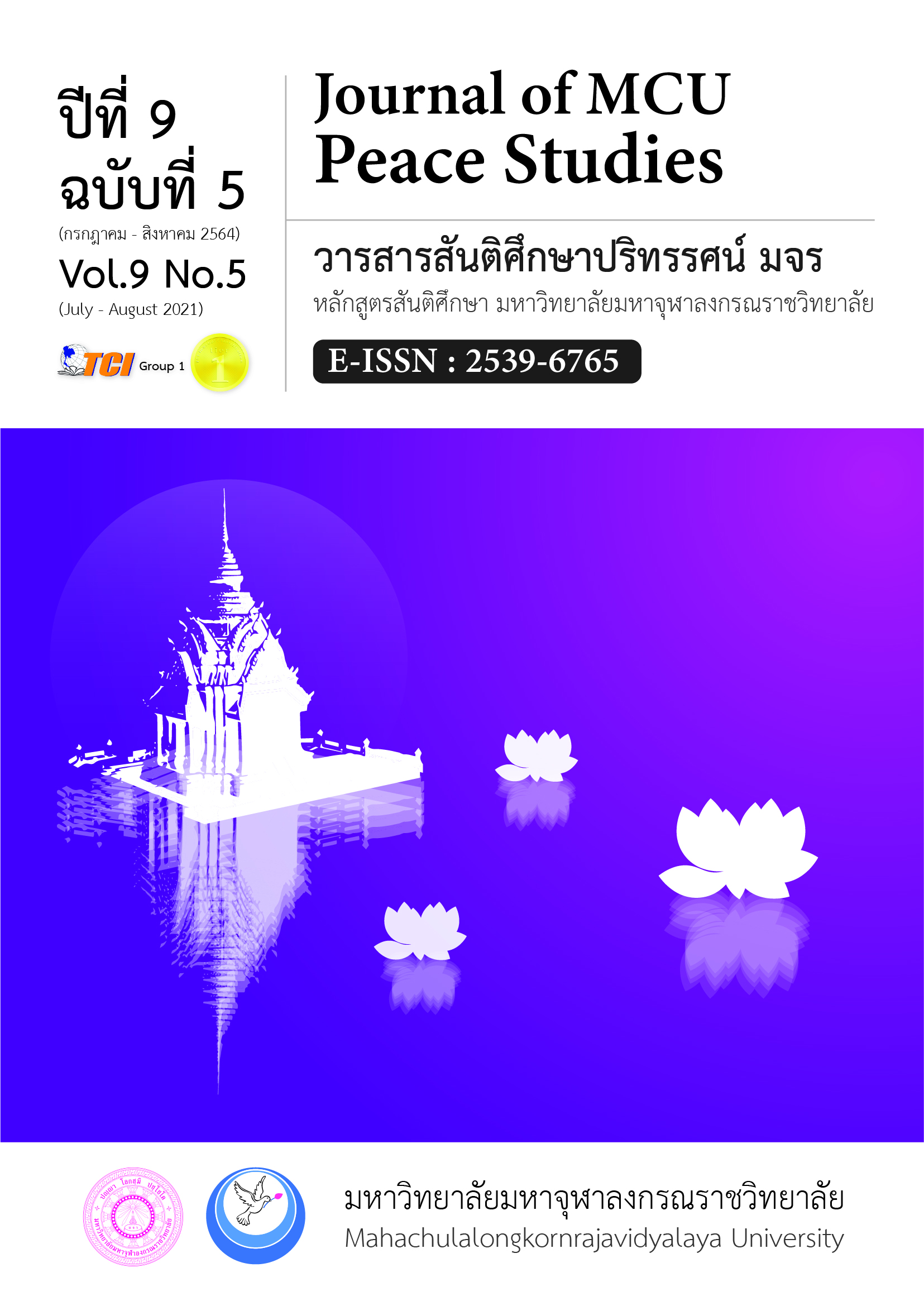บทบาทของจีนที่มีต่อการเปลี่ยนแปลง ภาพลักษณ์ของจังหวัดสีหนุวิลล์ประเทศกัมพูชา
Main Article Content
บทคัดย่อ
บทความวิจัยนี้มีวัตถุประสงค์เพื่อ 1) ศึกษาการเปลี่ยนแปลงภาพลักษณ์ของจังหวัดสีหนุวิลล์ ประเทศกัมพูชา และ 2) นำเสนอบทบาทของจีนที่มีต่อการเปลี่ยนแปลงภาพลักษณ์ของจังหวัดสีหนุวิลล์ ประเทศกัมพูชา กรอบแนวคิดที่ใช้ได้แก่ แนวคิดเรื่องการสร้างแบรนด์สถานที่ โดยเป็นการวิจัยเชิงคุณภาพด้วยการศึกษาจากเอกสารและทำการวิเคราะห์ข้อมูลโดยการวิเคราะห์เนื้อหา ผลการวิจัยพบว่า 1) รัฐบาลกัมพูชาได้วางเป้าหมายการพัฒนาและออกแบบภาพลักษณ์จังหวัดสีหนุวิลล์ไว้ 4 ประการ คือ (1) เมืองที่เป็นประตูสู่การติดต่อทางการค้าและการลงทุน (2) เมืองศูนย์กลางการคมนาคมขนส่งโลจิสติกส์ (3) เมืองศูนย์กลางอุตสาหกรรม และ (4) เมืองแห่งการท่องเที่ยวและการบริการ 2) บทบาทของจีนที่มีต่อการเปลี่ยนแปลงภาพลักษณ์ของจังหวัดสีหนุวิลล์ ประเทศกัมพูชา มี 2 รูปแบบ คือ (1) บทบาทจากการค้าและการลงทุนในรูปแบบการลงทุนโดยตรง และ (2) บทบาทการให้ความช่วยเหลือเพื่อการพัฒนาแก่สีหนุวิลล์
Article Details
ทัศนะและความคิดเห็นที่ปรากฏในบทความในวารสาร ถือเป็นความรับผิดชอบของผู้เขียนบทความนั้น และไม่ถือเป็นทัศนะและความรับผิดชอบของกองบรรณาธิการ ยินยอมว่าบทความเป็นลิขสิทธิ์ของวารสาร
เอกสารอ้างอิง
ASEAN Learning Center. (2017). Sihanoukville Special Economic Zone targets to Shenzhen of Cambodia. Department of Local Administration. Retrieved May 3, 2020, from https://www.asean.dla.go.th/public/1533484242517.
Briciu, V. (2013). Difference between Place Branding and Destination Branding for local brand strategy development. Bulletin of the Transilvania University of Braşov, Series VII: Social Sciences and Law, 1(1), 9-14.
Bühler, A. (2019). Development in Sihanoukcille under Chinese influence. Bangkok: Chulalongkorn University.
Chalermpansak, W. (2016). Chinese image’s perceived by neighboring countries via online newspaper of Cambodia, Laos, Myanmar and Vietnam. Nonthaburi: Sukhothai Thammathirat Open University Press.
Chantavanich, S. (2013) . Qualitative Research Method. (21st ed.). Bangkok: Chulalongkorn University Press.
Department of Trade Negotiations. (2016). Sihanoukville: The new economic and tourism center of Cambodia. Retrieved May 9, 2020, from https://uatapi.dtn.go.th/files/v3/download.
Department of International Trade Promotion in Phnom Penh. (2019). Sihanoukville today. Retrieved May 3, 2020, from https://www.ditp.go.th/ditp_web61/article_sub_view.
Kaewkumkong, A. (2012). Expanding Role of China’s trading in West Cambodia: Implications for Thailand. KKU Research Journal of Humanities and Social Sciences (business and economies), 11(2), 127-140.
Kamnak, P. (2019). Reproduction of the problem of inequality from the development of Chinese Capitalism. Retrieved May 3, 2020, from https://tcijthai.com/news/2019/6/article.
Marome, W. (2017). A Knowledge Assessment on Sustainable Cities in Thailand. Nakornpathom: Mahidol University.
Merrilees, B., Miller, D., & Herington, C. (2013). City Branding: A Facilitating Framework for Stressed Satellite Cities. Journal of Business Research, 66(1), 37-44.
Panyapiroje, C. (2015). Bangsaen destination brand image of Thai tourists. Chonburi: Burapha University.
Petersen, H. (2018). No Cambodia left: How Chinese money is Changing Sihanoukville. Retrieved May 3, 2020, from https://www.theguardian.com/cities/2018/jul/31/no-cambodia-left-chinese-money-changing-Sihanoukville.
Prachatai. (2019). Chinese investment transform “Sihanoukville” to Casino City Macau of ASEAN”. Retrieved May 17, 2020, from https://www.prachachat.net/aseanaec/news-285706.
Lertsatianchai, P. (2013). Review of Marxism (Rebel Cities). Journal of Social Research, 36(1), 139-150.
Rattanawaraha, A., & Thanapet, K. (2017). Urban Design and Development Guidelines for Tourist Cities towards Thailand 4.0: Case Studies of Phuket, Chiang Rai, and Phatthalung. The Strategic Plan for Sustainable Tourism Hubs for Thailand 4.0. Retrieved May 3, 2020, from http://www.cuurp.org/wp-content/uploads/2019/09/2-FINAL.
Santasombat, Y. (2015). Chinese Capitalism, ASEAN Economic Community Overseas Chinese in Southeast Asia (Research Report). Bangkok: The Thailand Research Fund.
Seesang, S. (2015). China and Fixation “The Big Dragon of ASEAN”. Digital Research Information Center. Retrieved May 18, 2020, from https://dric.nrct.go.th/index.php?/Detail/803/2.
Suwakan, P. (2019). The Strategy of Chinese investment in Mainland of Southeast Asia under Xi Jinping Policy in the 21st Century (Research Report). Bangkok: The Thailand Research Fund.
Ujjin, V. (2019). Chinese investment on the coastal area in Cambodia. Asia Trend. Retrieved May 9, 2020, from http://asiatrend.ias.chula.ac.th.
Yongsiri, W. (2014). Cambodia and the Great China: Xi Jinping Era (Part 1). Retrieved May 17, 2020, from http://www.ias.chula.ac.th/ias/th/Article-Detail.php?id=17.


